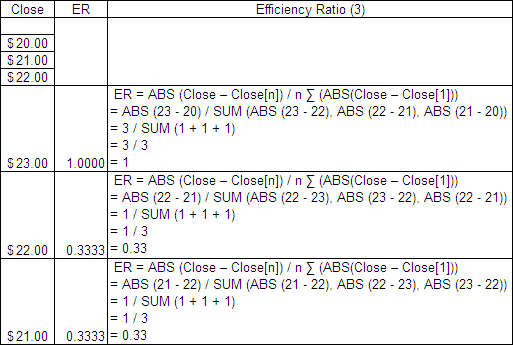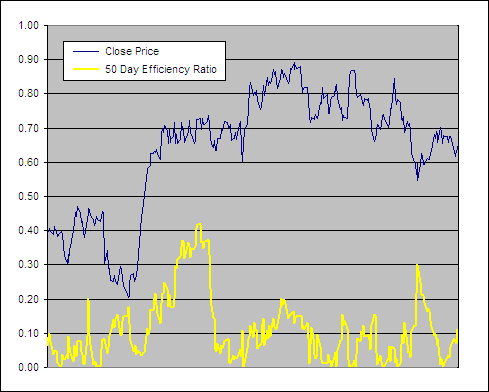The Efficiency Ratio (ER) was first presented by Perry Kaufman in his 1995 book ‘Smarter Trading‘. It is calculated by dividing the price change over a period by the absolute sum of the price movements that occurred to achieve that change. The resulting ratio ranges between 0 and 1 with higher values representing a more efficient or trending market.
The ER is actually very similar to the Chande Momentum Oscillator (CMO) presented by Tushar S. Chande in ‘The New Technical Trader‘ (1994). The difference is that the CMO takes into account for market direction but if you take the absolute CMO and divide by 100 you you get the Efficiency Ratio.
A measure of a trends strength can be very useful as some strategies work best on a trending market and some in a range bound market. Likewise different moving average lengths will perform better depending on the market type at that time.
Kaufman originally intended the Efficiency Ratio for use in his Adaptive Moving Average (KAMA). But in addition to the KAMA, as part of the Technical Indicator Fight for Supremacy we will be testing it as a component in a Variable Moving Average and an Indicator Weighted Moving Average.
.
How To Calculate the Efficiency Ratio
.
ER = Direction / Volatility
Where:
Direction = ABS (Close – Close[n])
Volatility = n ∑ (ABS(Close – Close[1]))
n = The efficiency ratio period.
Here is an example of a 3 period ER:
.

.
Efficiency Ratio Excel File
.
I have put together an Excel Spreadsheet containing the Kaufman’s Efficiency Ratio and made it available for FREE download. It contains a ‘basic’ version displaying the example above and a ‘fancy’ one that will automatically adjust to the length you specify. Find it at the following link near the bottom of the page under Downloads – Technical Indicators: Efficiency Ratio (ER).
.
Test Results
.
As part of the ‘Technical Indicator Fight for Supremacy‘ We have tested/will test the Efficiency Ratio as a component in several technical indicators:
- Efficiency Ratio Variable Moving Average (ER-VMA) – Completed – Results
- Efficiency Ratio Adaptive Moving Average (ER-AMA) – Completed – Results
- Efficiency Ratio Log Normal Adaptive Moving Average (ER-LAMA)
- Efficiency Ratio Weighted Moving Average (ER-WMA)
We will also test the ER as a filter, only taking trades when it indicates a strong trend.
.
Efficiency Ratio Example
.
